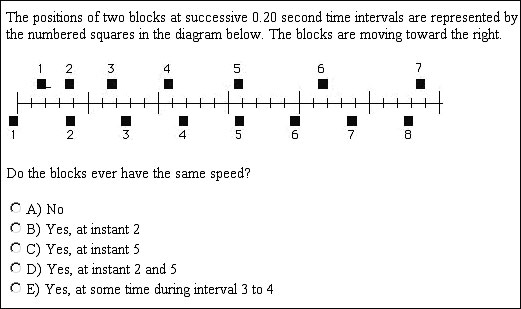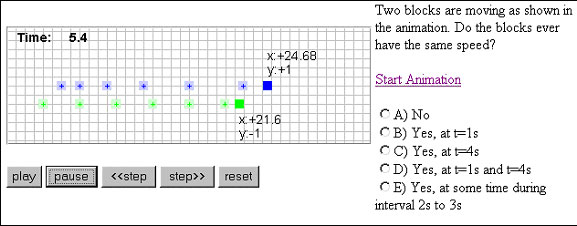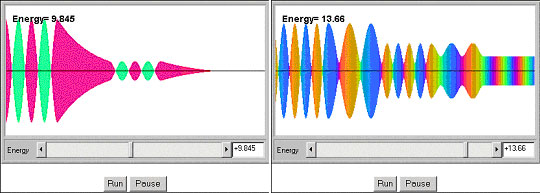Physlets: A Tool for Physics Education Research
Wolfgang Christian, Mario Belloni and Melissa Dancy
Overview
"Good educational software
and teacher-support tools, developed with full understanding
of principles of learning, have not yet become the norm." How
People Learn: Brain, Mind, Experience and School from
the Committee on Developments in the Science of Learning,
National Research Council National Academy Press, 1999. |
The impact of instructional software on mainstream
physics instruction has, at present, been minimal. At American Association
of Physics Teachers (AAPT) meetings in the 1980s, it was common to
see participants sharing floppy disks and trading software for the
computer-enabled educational reform that everyone knew was sure to
come. It didn't arrive, at least not in the form envisioned by the
conference participants. Little of the early educational software
was adopted by the mainstream teaching community and almost none
of it is still being used today. In contrast, printed material from
the much earlier post-Sputnik curricular reform movement - the Berkeley
Physics series, for instance - is still available and useful to physics
educators, although the pedagogy upon which it was based has gone
out of fashion. Will this scenario be repeated and are we doomed
like the Greek hero Sisyphus to forever push computational physics
up the hill of curriculum reform? Can we expect widespread adoption
of computation in the current curricular reform initiative? And,
if so, what strategies should we adopt to insure that computational-rich
curricula being developed today will be adopted and be in widespread
use a decade from now? Our approach has been to develop curricular
material that couples a software design philosophy with physics education
research (PER). It is based on open Internet standards such as Java,
JavaScript, and HTML as well as research into the effectiveness of
computer-based physics instruction.
Physlets - "Physics applets" -
are small, flexible Java applets that can be used in a wide variety
of applications [Christian 2001]. Because of their dynamic
interactivity, Physlets are ideally suited for interactive engagement
methods [Hake 1998, Sokoloff 1997, Thacker 1994] such as Just-in-Time
Teaching [Novak 1999] Peer Instruction [Mazur 1997] and Tutorials
[McDermott 1998]. In addition, Physlets can also be used as traditional
lecture demonstrations and can be given as end-of-chapter homework.
We have developed close to one thousand Physlet-based
problems over the past four years in support of a number of introductory
physics texts. A selection of these problems is available on the
CD that accompanies the Physlets book. More importantly,
the Physlets upon which these problems are based are freely distributable
for non-commercial educational purposes and are now being adapted
to support various curriculum reform initiatives.
Physlets and PER
Physics Education Research, PER, informs us that technology
does not necessarily lead to improved learning and that we are just
beginning to understand how it is best used. For technology to have
a long lasting impact on science education, it will need to be based
more on successful pedagogy than on the latest software and hardware.
For example, streaming video is currently a hot technology, and both
traditional broadcasters and software companies are competing to
establish themselves in this market. However, research has shown
that merely watching video has little effect on student learning,
and it is unlikely that streaming video will change this result.
Small cognitive effects have been shown to occur using video clips
if the showing of the clip is accompanied with in-class discussion
or if the clip is used for data taking and data analysis [Beichner
1997]. Two PER researchers, Aaron Titus [Titus 1998] and Melissa
Dancy [Dancy 2001], have used Physlets to study the effect of animation
on student assessment and student problem solving ability.
 n> n>
Figure 1: A media-focused projectile
problem.
Titus measured student attitudes and problem-solving
approaches while they were solving Physlet-based problems. The study
distinguishes between media-enhanced problems where multimedia is
used to present what is described in the text, and media-focused
problems, where the student must use multimedia elements in the course
of solving the problem. Titus found that media-focused problems are
fundamentally different from traditional physics problems, and Physlets
are ideally suited for these types of problems. Consider an example
from kinematics. A traditional projectile problem states the initial
speed and launch angle and asks the student to find the speed at
some point in the trajectory. This problem can be media-enhanced
by embedding an animation in the text, but this adds little to the
value of the problem. Alternatively, this same problem could be written
as a media-focused Physlet problem as shown in Fig. 1 where the student
is asked to find the minimum speed along the trajectory. In this
case, no numbers are given in the text.The student must observe the
motion, apply appropriate physics concepts, and make measurements
of the parameters he or she deems important within the Physlet. (A
mouse-down enables the student to read coordinates.) Only then can
the student "solve the problem." Such an approach is remarkably
different from typical novice strategies where students attempt to
mathematically analyze a problem before qualitatively describing
it (an approach often called "plug-and-chug" and characterized
by a lack of conceptual thought during the problem-solving process).

Figure 2: A text-based Force
Concept Inventory question.
Dancy used Physlets to probe students' conceptual understanding
by using a standard diagnostic instrument, the Force Concept Inventory
[Hestenes 1992], in which all thirty static pictures (see Figure
2) were replaced by Physlet-based animations (see Figure 3) [Dancy
2001]. Both quantitative and qualitative data was collected from
hundreds of students using the Physlet-based version and the results
were statistically analyzed. The study showed that Physlet-based
problems are less likely to elicit memorized responses because they
allow students to respond to what they see, rather than what they
read. Physlets tap into students' intuition and deeply-held misconceptions
by eliminating the additional step of translating from words or graphs.
In general, students had a better understanding of the intent of
the questions when viewing an animation and gave an answer that was
more reflective of their actual understanding. Dancy speculates that
this may be because the animation looks more like real life than
something from a physics textbook.

Figure 3: A Physlet-based Force
Concept Inventory question.
Both the Titus and the Dancy studies indicate that
while computer-based animation can be used for cosmetic and motivational
purposes, they are most effective under the following conditions:
- The animation is integral to the question.
- The student must interact with the animation to
obtain data.
The effectiveness of Physlets likely depends on many
factors such as how well the task targets known student difficulties,
how students use visual cues given by the Physlet, how important
visualization is to the given task, and the appropriateness of the
Physlet to the given task. Nevertheless both studies show that conceptual
understanding is key to solving Physlet problems. Without strong
conceptual understanding, students are prone to guess, search for
the "right" equation, and lack direction.
Just-in-Time Teaching
Although the media-rich content and interactivity provided
by technology such as Physlets can be pedagogically useful, it can
lack the human dimension that is important to effective teaching.
Computer Assisted Instruction (CAI) has already been tried on very
elaborate proprietary systems. It is unlikely to be improved significantly
by being ported to the Internet. To be truly effective, the communication
capabilities of the computer must be used to create a feedback loop
between instructor and student. A new and particularly promising
approach known as Just-in-Time Teaching, JiTT,
has been pioneered at Indiana University and the United States Air
Force Academy and further developed at Davidson College [Novak 1999].
It employs a fusion of high-tech and low-tech elements. On the high-tech
side, it uses the World Wide Web to deliver multimedia curricular
materials and manage electronic communications between faculty and
students. On the low-tech side, the approach requires a classroom
environment that emphasizes personal teacher-student interactions.
These disparate elements are combined in several ways, and the interplay
produces an educational setting that students find engaging and instructive.
The underlying method creates a synergy between the Web and the classroom
to increase interactivity and allow rapid response to students' problems.
| Figure 4: JiTT Yo-Yo Puzzle
Question: Make yourself a yo-yo by wrapping a fine string around
a thin hoop of mass M and radius R. Pass the string around
a pulley and attach it to a weight, whose mass is exactly half
the mass of the hoop. Then release the system from rest. Describe
the subsequent motions of the yo-yo and the weight. You may
use equations to arrive at your answer, but you must state
your result in plain sentences. |

|
| Figure 5: Physlet-based JiTT
Moment of Inertia Puzzle Question: Rank simulation 1 and simulation
2 from least to greatest in terms of the moment of inertia
of the wheel, the tension in the string, and the total angular
momentum about the wheel's axle after 4 seconds. The hanging
weights have identical mass. |

|
The JiTT pedagogy exploits an interaction between web-based
study and an active-learner classroom. Essentially, students respond
electronically to carefully constructed web-based assignments, and
the instructor reads the student submissions "just-in-time" to
adjust the lesson content and activities to suit the students' needs.
Thus, the heart of JiTT is the "feedback loop" formed by
the students' outside-of-class preparation which fundamentally affects
what happens during the subsequent in-class time.
Although JiTT can be implemented fully using technically
simple Web-based assignments, incorporating Physlet-based questions
can heighten the extent to which student under-standing can be probed
and encouraged. The JiTT strategy as applied in physics education
is richer for the incorporation of Physlets. Consider, for example,
the puzzles shown in Figures 4 and 5. These Puzzles involve nearly
the same physics, but what is required of the student in order to
solve each puzzle is quite different. In each case, the student
must understand the concepts of moment of inertia, torque, angular
acceleration, angular velocity, and the relationships between those
quantities. In each case, it also behooves the student to draw "extended" free
body diagrams to consider the forces and torques involved. The dynamic
Puzzle, however, requires some visual analysis and understanding
of how the speed with which the mass falls is related to the physics
quantities such as angular momentum and moment of inertia. Students
are expected to analyze each situation, apply the relevant physics,
and answer specific questions. The faculty member then prepares
a lecture in response to the student submissions.
Conclusion
Based on our results, we believe that Physlets can
be a valuable tool for creating interactive curricular material designed
around the needs of the student. We have investigated using Physlets
to alter existing curricular material. However, the greatest potential
of Physlets will come from using Physlets to ask (and answer) questions
in ways which cannot be done on paper [Belloni 2001]. (see also Figure
6.)

Figure 6: Physlet-based
JiTT question regarding the quantum mechanical barrier problem. Students
are asked to find the potential energy by varying the energy and
examining the shape of the free-particle wave function.
The best media-focused problems cannot be correctly
solved using "plug-and-chug" methods. The fact that data
is not given in the text of the problem requires that students apply
proper conceptual understanding to the solution before analyzing
data. Therefore, it also seems that Physlet problems may be useful
for encouraging a "concept-first" approach to solving problems,
where students consider the concepts or principles to be applied
to the problem before making calculations. This quality seems to
make Physlets well suited for evaluating students' application of
conceptual understanding to numerical problems and helping students
identify weaknesses in conceptual understanding.
Acknowledgements
Portions of the work presented here are based on published
and unpublished work in collaboration with Melissa Dancy, Aaron Titus,
and Evelyn Patterson.
The author would like to acknowledge the National Science
Foundation, grant DUE-9752365, for its support of Physlets.
References
[Christian 2001] "Physlets: Teaching Physics
with Interactive Curriculum Material," W. Christian and
M. Belloni, Prentice Hall, Upper Saddle River, (2001) See also: http://webphysics.davidson.edu/applets/applets.html
[Hake 1998] R. R. Hake, "Interactive-engagement
vs. traditional methods," Am. J. Phys., 66, 64--74
(1998)
[Sokoloff 1997] D. R. Sokoloff, "Using Interactive
Lecture Demonstrations to Create an Active Learning Environment," The
Physics Teacher, 35, 340 (1997).
[Thacker 1994] B. Thacker, "Comparing Problem
Solving Performance of Physics Students in Inquiry-based and Traditional
Introductory Courses," American Journal of Physics,
62, 627-633. (1994).
[Novak 1999] "Just-in-Time Teaching: Blending
Active Learning with Web Technology," G. M. Novak, E.
T. Patterson, A. D. Gavrin, and W. Christian, Prentice Hall, Upper
Saddle River, 1999.
[Mazur 1997] "Peer Instruction: A Users Manual," E.
Mazur, Prentice Hall, Upper Saddle River, 1997.
[McDermott 1998] "Tutorial in Introductory
Physics," L. McDermott and P. S. Shaffer, Prentice Hall,
Upper Saddle River, 1998.
[Beichner 1997] R. Beichner, "The Impact of Video
Motion Analysis on Kinematics Graph Interpretation Skills," American
Journal of Physics, 64, 1272-1277. (1997).
[Titus 1998] A. Titus, "Integrating Video
and Animation with Physics Problem Solving Exercises on the World
Wide Web," Ph.D. dissertation. North Carolina State University:
Raleigh, NC. (1998).
[Dancy 2001] M. Dancy, "Investigating Animations
for Assessment with an Animated Version of the Force Concept Inventory," Ph.D.
dissertation. North Carolina State University: Raleigh, NC. (2001).
[Hestenes 1992] D. Hestenes, M. Wells, and G. Swackhamer, "Force
Concept Inventory," The Physics Teacher, 30, 141--158
(1992).
[Belloni 2001] M. Belloni, L. Cain, and W. Chrisian, "Using
Physlets and Just-in-Time Teaching in Quantum Mechanics," AAPT
2001 Summer Meeting, Rochester, NY, 2001. See also: http//webphysics.davidson.edu/qmbook/
Wolfgang Christian, Mario Belloni and Melissa Dancy
are at Davidson College, Davidson NC 28036. W. Christian
is a Professor Physics. His research interest is in the area
of computational physics and instructional software design. He
is co-author of Physlets: Teaching Physics with Interactive
Curricular Material (2001), Just-in-Tiome Teaching (2000),
and Waves and Optics (1995). M. Belloni is an
Assistant Professor of Physics and his research interests are in
theoretical physics and physics education. M. Dancy is a
Visiting Assistant Professor with research interests in physics
education and instructional technology.
|